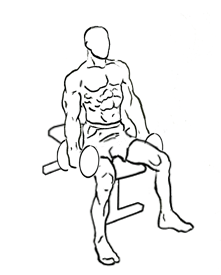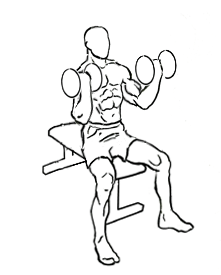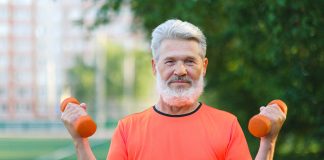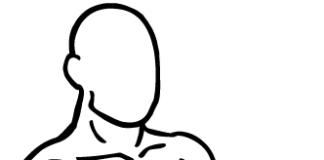Last Updated on September 30, 2014
If you’re aiming for full, well-defined biceps, it’s essential to target all angles of the muscle. While traditional bicep curls are great, they often focus more on the outer bicep and lack the specialized isolation needed to build the inner part of the biceps, the section that creates the coveted “peak” when you flex. Enter the Seated Inner Biceps Curl with Dumbbell: a highly focused exercise that isolates the inner biceps and helps develop that full, round look in the arms. This move is particularly effective for lifters seeking to boost bicep definition and add dimension to their upper arms.
This article will break down everything you need to know about the Seated Inner Biceps Curl with Dumbbell, from the benefits and setup to mastering the form, maximizing muscle engagement, and understanding how to avoid common mistakes that could impede your progress. By the end, you’ll have a clear picture of how this powerful exercise can take your arm workouts to the next level.
Why the Seated Inner Biceps Curl with Dumbbell?
The Seated Inner Biceps Curl with Dumbbell is a variation of the classic dumbbell curl, modified to emphasize the inner portion of the biceps. This muscle group, which runs along the inner edge of the arm, often gets less direct attention in other bicep exercises. This exercise not only works the long head of the biceps—the part responsible for height and peak—but also provides a unique twist in the movement that targets the inner muscle fibers, helping to round out your biceps for a balanced, three-dimensional look.
By turning the palms up and out during the curl, you’re able to engage the inner biceps more effectively, creating the type of tension needed for significant gains in both strength and muscle shape. The seated position also offers stability, allowing you to focus on each rep without relying on body momentum. It’s a powerful move for seasoned lifters looking to refine their biceps as well as for beginners focused on building solid arm foundations.
Setting Up for the Seated Inner Biceps Curl with Dumbbell
To start, find a sturdy bench and a pair of dumbbells with a manageable weight. This exercise is about control, not just lifting heavy, so choose weights that allow for precision without compromising form. Sit on the edge of the bench with your feet firmly planted on the floor about shoulder-width apart. Keep your back straight, chest open, and core engaged to support stability and maintain proper posture throughout each rep.
Grasp a dumbbell in each hand with your arms fully extended along your sides. Start with a neutral grip, meaning your palms are facing each other. This initial position may seem simple, but it’s essential to avoid swinging your arms or leaning forward, as these movements can reduce the effectiveness of the curl and strain your lower back.
Performing the Seated Inner Biceps Curl with Dumbbell: Step-by-Step Breakdown
With your starting position set, it’s time to dive into the movement itself. Here’s a full breakdown of each phase of the curl:
The Initial Lift
Begin by curling the dumbbells upward and outward in a smooth, controlled motion. As you raise the weights, twist your palms so they’re facing up and outwards. This slight turn activates the inner biceps more than a standard curl would, creating a contraction that targets the inner muscle fibers. The upward and outward angle is key—this outward rotation encourages the engagement of those inner bicep muscles, helping to build the fullness that contributes to a rounded, developed look in the upper arms.
Peak Contraction
As you reach the top of the curl, hold the position briefly to achieve peak contraction. Squeeze your biceps hard at the top, focusing on creating a mind-muscle connection that can be felt in the inner part of the biceps. This peak contraction is where you’ll feel the most intense engagement in your muscles, and it’s crucial for maximizing growth.
The Lowering Phase
Once you’ve held the top of the curl momentarily, slowly lower the weights back to the starting position. Control is key here; a slow, controlled descent keeps tension on the biceps, enhancing the exercise’s effectiveness. Avoid letting gravity do the work—your muscles should be in control for the entire range of motion. By fully extending your arms back down to the starting position, you’re stretching the bicep muscles and maintaining tension through the eccentric (lowering) phase of the movement.
Benefits of the Seated Inner Biceps Curl with Dumbbell
The Seated Inner Biceps Curl with Dumbbell offers a host of benefits beyond mere aesthetics. Here’s how this exercise can support your strength goals:
- Targeted Inner Bicep Activation: The unique twist in this exercise isolates the inner bicep, allowing for focused muscle engagement. This makes the exercise especially effective for achieving well-rounded biceps, which contributes to a balanced and proportional look.
- Increased Arm Definition: By working the inner bicep with a slow, controlled movement, this curl helps define the muscles in the upper arm, enhancing the peak and shape of the biceps.
- Stability and Posture: The seated position with the back straight promotes core engagement, stability, and proper posture. This helps prevent any sway or momentum, which can detract from the bicep-focused nature of the movement.
- Enhanced Mind-Muscle Connection: Since the exercise requires controlled movement and careful positioning, it helps improve the mind-muscle connection, making you more aware of how your biceps are working with each rep.
Tips for Maximizing Your Gains
To get the most out of the Seated Inner Biceps Curl with Dumbbell, consider these tips:
- Prioritize Control Over Weight: While it might be tempting to grab heavier dumbbells, this exercise is about isolating the biceps rather than lifting maximum weight. Opt for a weight that allows you to maintain control without breaking form.
- Engage Your Core: Keep your abs drawn in to provide stability and avoid rocking or swaying as you lift. This helps direct the work to the biceps, making each rep more effective.
- Full Range of Motion: Make sure you’re fully extending and curling each rep. Stopping short of a full range reduces muscle activation and limits the effectiveness of the exercise.
- Experiment with Angles: While the outward curl emphasizes the inner biceps, slight variations in angle can also target different areas of the muscle. Play with the outward angle to find what works best for you.
Common Mistakes to Avoid
Even with a straightforward movement, common mistakes can hinder your progress and potentially lead to injury. Here are a few pitfalls to watch for:
- Using Momentum: Avoid swinging your arms or leaning back as you lift. This momentum takes the focus off the biceps and reduces the effectiveness of the isolation. Each rep should be controlled, with the biceps doing all the work.
- Not Turning the Palms: Skipping the outward turn of the palms is a common mistake that misses the inner bicep activation. This slight twist is crucial for targeting the inner portion of the biceps and achieving balanced development.
- Lowering the Dumbbells Too Quickly: The lowering phase is just as important as the lifting phase. Rushing through this part can reduce muscle engagement and increase the risk of strain. Focus on lowering the dumbbells slowly and with control.
- Lifting Too Heavy: It’s better to use a moderate weight that allows for good form and control. Using excessively heavy weights may lead to poor form, reducing the benefits and increasing the likelihood of injury.
Integrating the Seated Inner Biceps Curl into Your Routine
The Seated Inner Biceps Curl with Dumbbell can be incorporated into your workout routine in a variety of ways, depending on your goals. As an isolation exercise, it’s ideal for adding volume to your arm workout, particularly if you’re working towards bicep growth and definition.
Consider using it as a finisher on bicep day to fully fatigue the muscles after compound movements, like barbell curls or pull-ups. Aim for 3-4 sets of 10-12 reps, with a weight that allows for strict form and control. For those prioritizing endurance, slightly higher reps (12-15) with lighter weights can be beneficial. Adjust based on your training goals, and remember that the focus should always be on quality reps over quantity.
Final Thoughts: Building Stronger, More Defined Biceps
The Seated Inner Biceps Curl with Dumbbell is a must-try exercise for anyone serious about building well-defined, balanced arms. Its unique twist on a traditional curl isolates the inner biceps in a way that’s difficult to achieve with broader compound exercises. By incorporating this exercise into your routine, you’ll not only add definition to your biceps but also develop a peak that complements the overall shape and aesthetic of your upper arms.
Remember, achieving your goals with this exercise requires a combination of patience, consistency, and attention to detail. Focus on controlled reps, prioritize form over weight, and engage your muscles with intention. Over time, the payoff will be clear: stronger, fuller, and more defined biceps that make your arms stand out. So grab a pair of dumbbells, set up your bench, and get ready to take your bicep training to the next level with the Seated Inner Biceps Curl.








